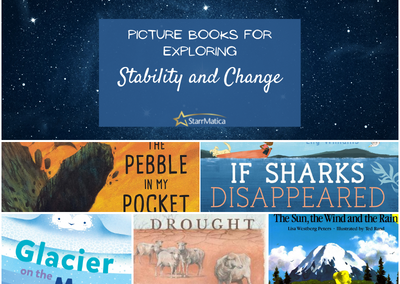Picture books are a great way to get students to examine the crosscutting concepts of the Next Generation Science Standards. New to the crosscutting concepts? Here’s a quick summary! The crosscutting concepts are one of the three dimensions of the NGSS. The seven crosscutting concepts are lenses through which your students can examine different phenomena. Using the CCC helps students to better understand both known and unfamiliar phenomena, so it can be worthwhile to spend some time helping them to dig in and really understand what each concept means. Using picture books can help make the CCC accessible to students of all ages!
The picture books shared below are fantastic for examining the crosscutting concept of Stability and Change. Whether you are reading them aloud, having students explore them in small groups, or having students read them independently, the following questions can be used to help students focus on stability and change:
- What is happening in this system?
- Is it stable or changing?
- If it is stable, is it in a state of dynamic equilibrium?
- If it is changing, what is the energy or matter that caused the system to change?
- Why does scale matter when examining stability and change?
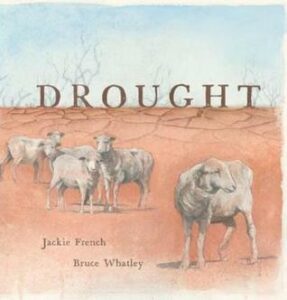 Books about natural disasters are excellent for exploring the concept of stability and change. Students can discuss how the natural disaster changes the environment and the organisms living in it, and how the system can be brought back to stability.
Books about natural disasters are excellent for exploring the concept of stability and change. Students can discuss how the natural disaster changes the environment and the organisms living in it, and how the system can be brought back to stability.
With striking illustrations, Drought by Jackie French depicts the effects of a several year drought on both the landscape and the people and animals living there.
Questions to Discuss: Why is forecasting a drought more difficult than forecasting other weather events? What solutions can you brainstorm that may result in better drought prediction? What solutions can you brainstorm that could help people prepare for and survive a severe drought? Where do droughts occur in the world today? Why do they occur in those places? Where are droughts predicted to occur in the future? Why?
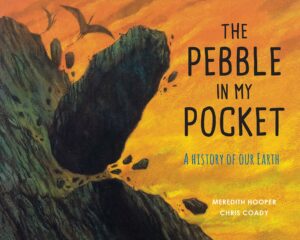 The Pebble in My Pocket: A History of Our Earth by Meredith Hooper shares the story of one single pebble from Earth’s beginning to the present day. This text is perfect for discussing stability and change over a longer time scale.
The Pebble in My Pocket: A History of Our Earth by Meredith Hooper shares the story of one single pebble from Earth’s beginning to the present day. This text is perfect for discussing stability and change over a longer time scale.
Old Rock (is Not Boring) by Deb Pilutti would be a great text to pair with this text or as an alternative for younger listeners. On the surface Old Rock may appear to be boring, but as his storytelling unfolds and his friends learn about all the earth events he has seen and experienced, they realize that he is anything but boring!
Activity Idea: Collect different kinds of rocks and pass them out to your students. Invite them to think about everything their rock has seen and where it has been. Let this springboard into a storytelling activity or a creative writing activity.
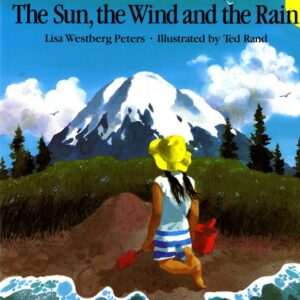
The Sun, the Wind, and the Rain by Lisa Westberg Peters is one of my favorites because of its flexibility with the crosscutting concepts. It could also be used to highlight systems and system models, cause and effect, and scale, proportion and quantity just as easily as stability and change. In this text, the formation, weathering, and erosion of a mountain is compared to the construction and erosion of a sandcastle on the beach.
Question to Discuss: How is the formation, weathering, and erosion of the mountain and the sandcastle both similar and different?
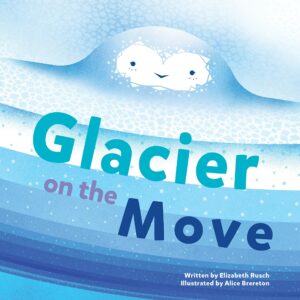
In Glacier on the Move by Elizabeth Rusch, an anthropomorphized glacier tells the story of its movement interspersed with facts about glaciers.
After reading, students can explore how glaciers around the world are changing with NASA’s global ice viewer. https://climate.nasa.gov/interactives/global-ice-viewer/#/
And then you can engage in a discussion about how we know if glaciers are stable or changing and the many consequences we may experience as glaciers become unstable.
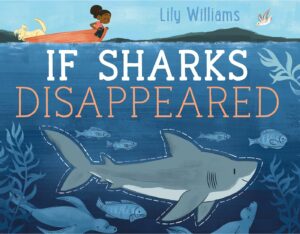 If Sharks Disappeared by Lily Williams explores the interconnectedness of life by describing the chain reaction of events that could happen if sharks disappeared from the planet.
If Sharks Disappeared by Lily Williams explores the interconnectedness of life by describing the chain reaction of events that could happen if sharks disappeared from the planet.
Questions to Discuss: Do you think a similar chain of events would happen if a different apex predator disappeared? What about if an animal farther down the food chain disappeared? Why do you think that?
Investigation Idea: This is the perfect opportunity for students to investigate a favorite animal and to determine what chain of events could happen if that animal disappeared. Have students present their findings to the class using media of their choice.
If you are a StarrMatica Texts: Science Your Way subscriber, you can check out the texts below that align with an exploration of stability and change. Remember, each 1st – 5th grade text has multiple reading levels so all of your students can read the same content independently.
- Kindergarten: The Different Seasons; The Four Seasons; How Animals Change Their Environments; Changing an Environment; Bottle It Up; Talking Trash; Helping the Planet; Taking Care of Earth
- Second grade: Earth Changes Can Be Fast and Slow!; Building Better Beaches; Preventing Erosion
- Third grade: Protecting the Giant Pandas; Saving the Giant Pandas
- Fourth grade: Rainbow Rocks; Curious Clouds and CFCs; A Race Toward Ozone Recovery; Fossil Fuels and Clean Energy; Plants Power Our Future; Can You Stop an Earthquake?
- Fifth grade: Does Farming Help or Harm the Earth?; Why Are Forests Disappearing?
Not a subscriber? Click here for a free trial to access the texts above.
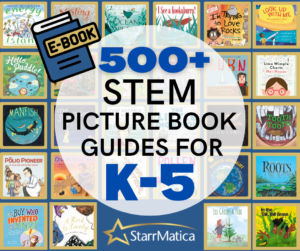 And if you are looking for additional picture books for your science classroom, check out the Perfect Picture Book Pairing Series that includes one-page guides with activities and discussion questions for hundreds of STEM-themed picture books aligned to every NGSS performance expectation!
And if you are looking for additional picture books for your science classroom, check out the Perfect Picture Book Pairing Series that includes one-page guides with activities and discussion questions for hundreds of STEM-themed picture books aligned to every NGSS performance expectation!
CLICK HERE TO PREVIEW THE PERFECT PICTURE BOOK PAIRING EBOOKS
Be sure to check out the other posts in this series to discover picture books to highlight each of the seven crosscutting concepts in the NGSS!
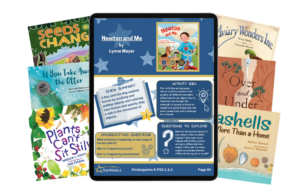
Want to save even more time with lesson ideas for 35 picture books that you can use to highlight all seven crosscutting concepts?
Enter your information below to receive your complimentary picture book guides including activity ideas, science questions, and crosscutting concept questions!

